Key takeaways:
- Divergence trading signals potential reversals, combining price movements and momentum indicators like RSI and MACD is essential for strategic trading.
- Thorough market analysis helps traders make informed decisions, aligning technical indicators with market sentiment can reveal deeper insights.
- Combining multiple indicators, managing risks with stop-loss orders, and understanding market context are crucial for successful divergence trading.
- Patience and emotional control are vital; waiting for confirmations and reflecting on past trades enhances decision-making and overall trading strategies.
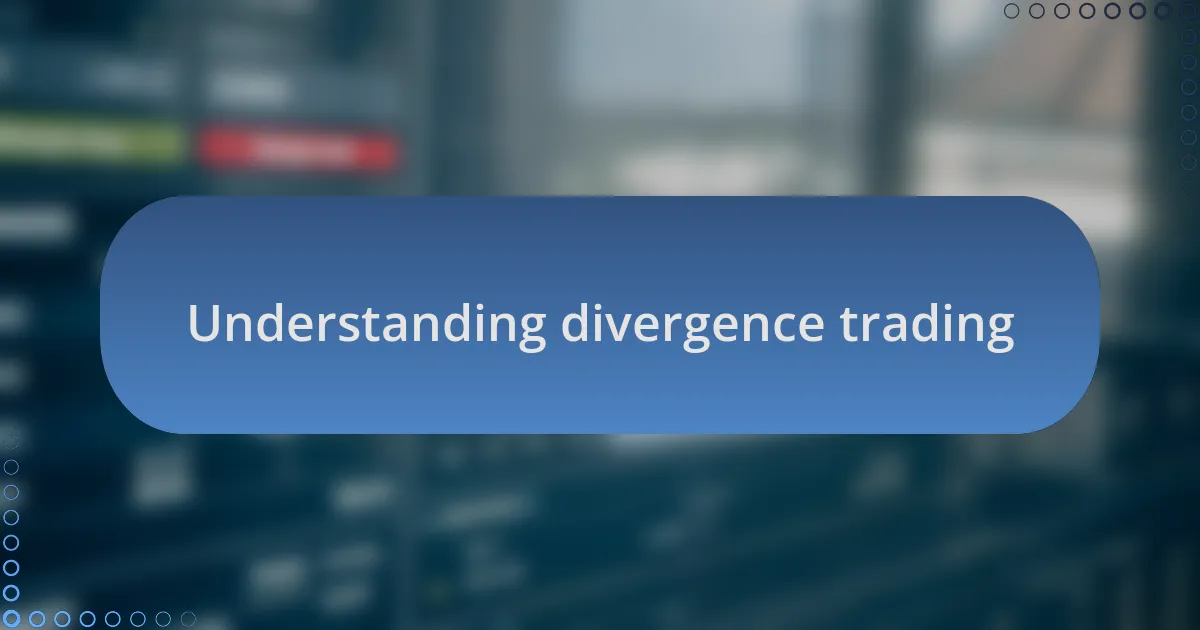
Understanding divergence trading
Divergence trading is one of those fascinating concepts that can really change how we view price movements in the crypto markets. Essentially, it occurs when the price of an asset moves in one direction while an indicator, like the Relative Strength Index (RSI) or Moving Average Convergence Divergence (MACD), moves in the opposite direction. I remember the first time I stumbled upon this—seeing a price rise while the RSI was dropping felt like uncovering a secret about market psychology.
Understanding divergence is crucial because it often signals potential reversals, giving traders the opportunity to enter or exit positions strategically. I once witnessed a sharp decline in a popular altcoin’s value, even as the RSI was showing bullish signs. It was a stark reminder of how important it is to consider both price action and emotional sentiment when making trading decisions. Have you ever felt that gut instinct telling you something isn’t right despite what the charts say?
As I navigated through my trading journey, I realized that spotting divergence isn’t a foolproof strategy, but it certainly adds depth to market analysis. It requires a keen eye and sometimes a leap of faith. It’s intriguing to think about how many traders overlook these signals only to miss out on significant market shifts—doesn’t that make you want to pay closer attention?

Importance of market analysis
Market analysis is vital in trading because it provides insights into price trends and potential future movements. I often find myself reflecting on the times I neglected thorough analysis, only to watch a potential opportunity slip away. It’s like setting out on a road trip without a map—exciting but fraught with unexpected turns.
When I conduct a market analysis, I look beyond just the surface-level data. During one particular trading session, I noticed that a downturn in market sentiment was corroborated by declining trading volumes, which signaled a more profound issue at play. This experience taught me the importance of aligning market indicators with emotional trends. After all, haven’t you observed how fear or greed can drastically shift the charts?
Ultimately, the ability to interpret market signals empowers traders to make informed decisions. I often ask myself—how can I trust my instincts without the data to back them up? With a solid foundation in market analysis, I feel more confident in navigating the unpredictable waters of the crypto landscape, reducing the anxiety that often accompanies trading.
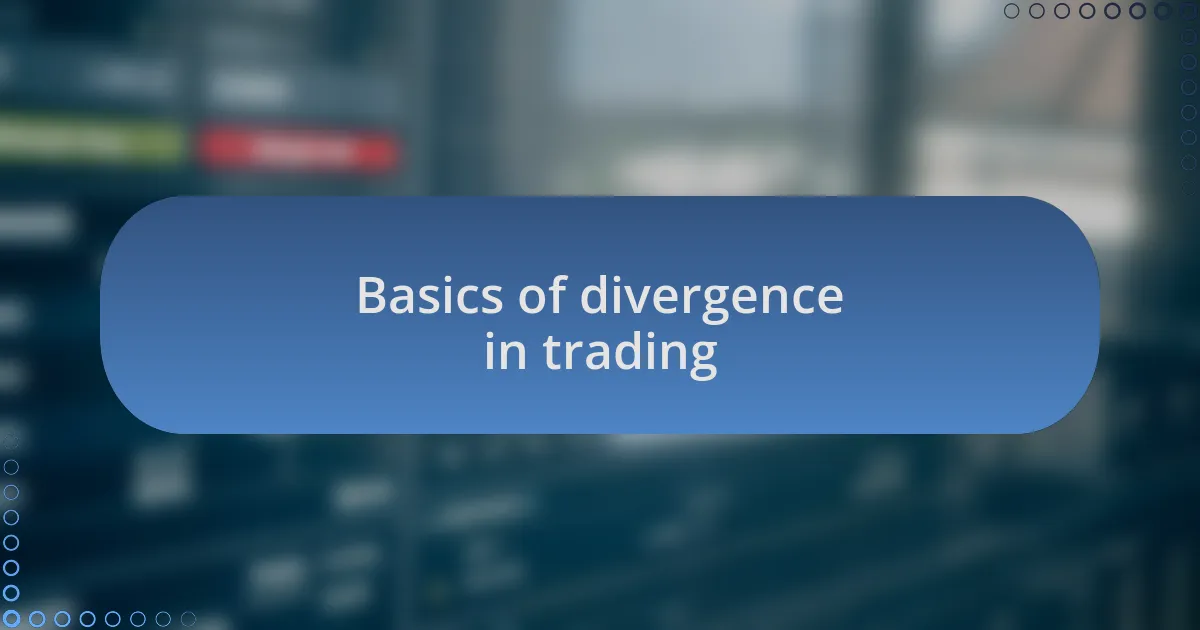
Basics of divergence in trading
Divergence in trading is a powerful concept that can signal potential reversals in price trends. I remember a time when I spotted a bearish divergence while trading. The price was making higher highs, but the momentum indicator was forming lower highs. It was a classic sign that something was off, urging me to reconsider my position before the market shifted dramatically.
Understanding divergence requires recognizing the relationship between price action and momentum indicators, such as the Relative Strength Index (RSI) or Moving Average Convergence Divergence (MACD). I often find myself drawn to situations where the price moves contrary to momentum, asking, “What does this discrepancy reveal?” This questioning has been invaluable; it highlights the potential for trend exhaustion—an insight I’ve leveraged successfully in my trading strategy.
Ultimately, identifying divergence is more than just a technical analysis tool; it taps into the psychology of traders. When I see a divergence, it evokes a sense of urgency and caution. It’s a reminder that the market can behave irrationally, and being aware of these signals feeds my instinct to approach trading with both excitement and diligence. Do you ever feel that rush of intuition when you spot a divergence? It’s one of those moments that can truly reshape your trading perspective.
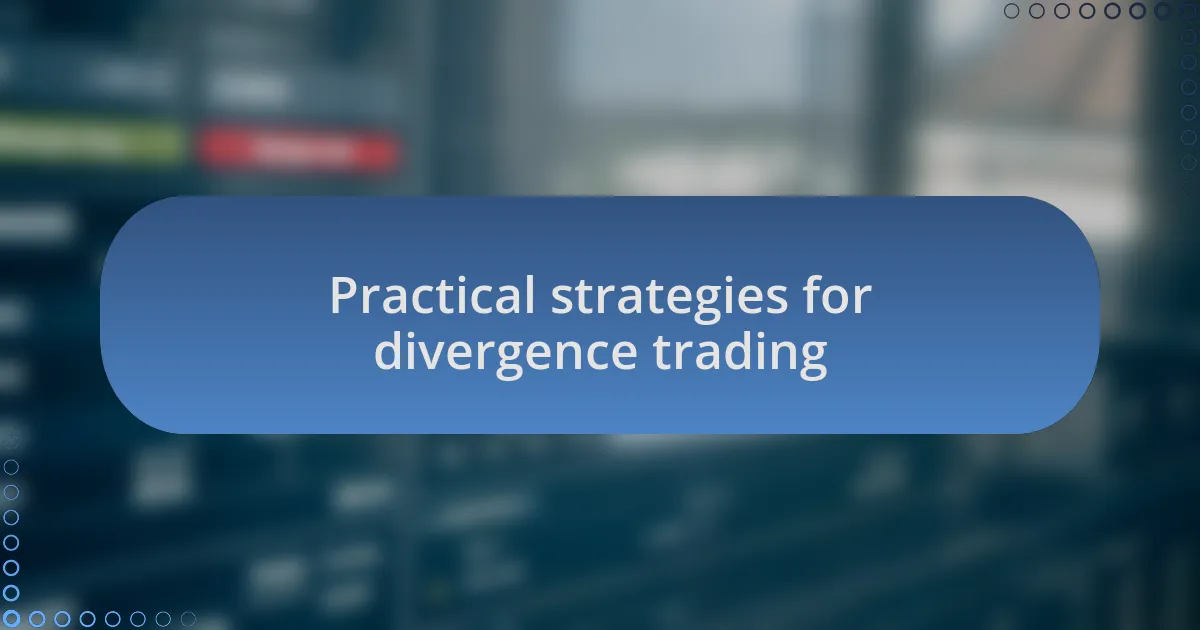
Practical strategies for divergence trading
One effective strategy I’ve used in divergence trading involves combining several momentum indicators. For instance, I often look at both the RSI and MACD together. When they signal divergence at the same time, the potency of that signal increases significantly. The times I’ve acted on this dual confirmation have often led to timely and profitable trades.
Another tactic is to manage my risk through proper stop-loss placement. I’ve learned the hard way that even the most promising divergence signals can sometimes fail. When I set my stop loss just beyond the swing high or low, depending on whether I’m taking a long or short position, it gives me that extra layer of protection. Does this sound familiar? Keeping emotions in check when trades go against you can be challenging—it’s essential to have a fail-safe strategy.
Finally, I ensure to always consider the broader market context. I recall a time when I ignored fundamental news that contradicted a strong bullish divergence. The result was a painful lesson. Understanding the fundamental landscape helps ground my technical insights and assures that I’m not chasing false signals. This combined approach—technical analysis, risk management, and market awareness—has truly deepened my understanding of divergence trading and enhanced my overall success.
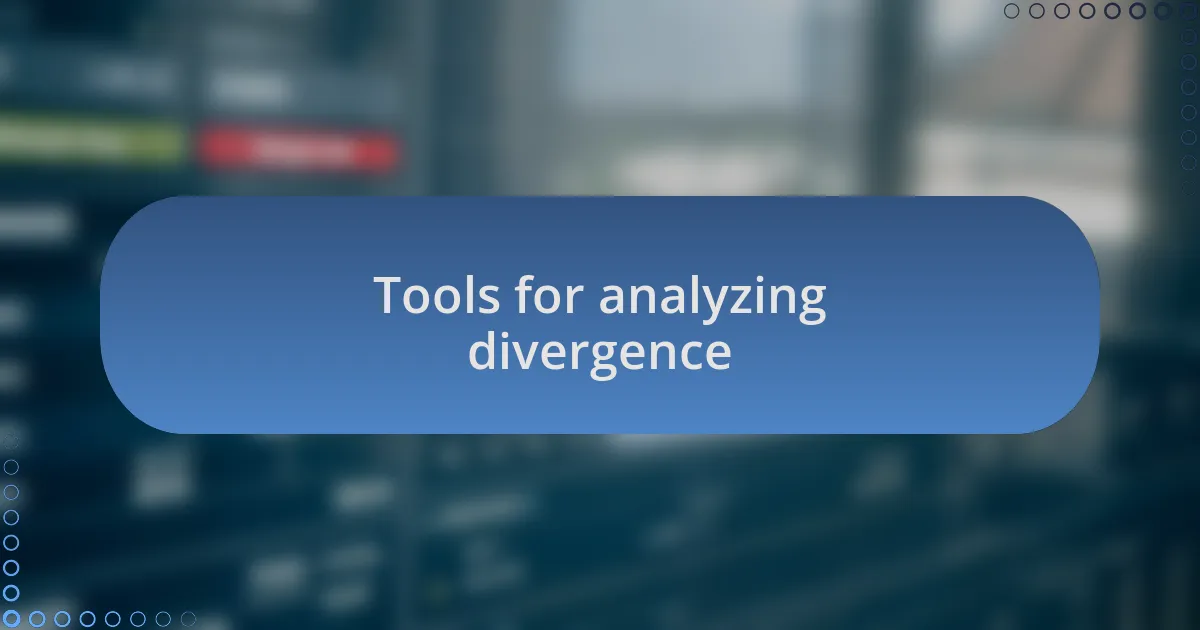
Tools for analyzing divergence
When it comes to tools for analyzing divergence, charting software is indispensable. I often rely on platforms like TradingView, where I can customize my charts with various indicators. There’s something exhilarating about tweaking settings and then watching how divergent patterns unfold in real time. Have you ever experienced that moment when a chart suddenly reveals a divergence you hadn’t noticed before? It’s like uncovering hidden treasure.
Another tool I frequently use is the Fibonacci retracement tool. This can be incredibly useful in conjunction with divergence analysis. I’ve found that connecting swing highs and lows with Fibonacci lines can help pinpoint potential reversal areas. During my early days of trading, I remember missing out on significant moves because I overlooked these intersecting points. Understanding how divergence correlates with Fibonacci levels has since improved my accuracy.
Let’s not overlook the importance of mobile trading applications. Having access to your favorite analysis tools on the go means you can capture divergence opportunities without being tied to your desk. I remember one instance when I spotted a divergence while out and about; I quickly acted on it with just my phone in hand. That immediate action not only boosted my confidence but also turned out to be a rewarding trade. How often do you find yourself missing opportunities because you aren’t ready to engage? It’s a game-changer to stay connected.
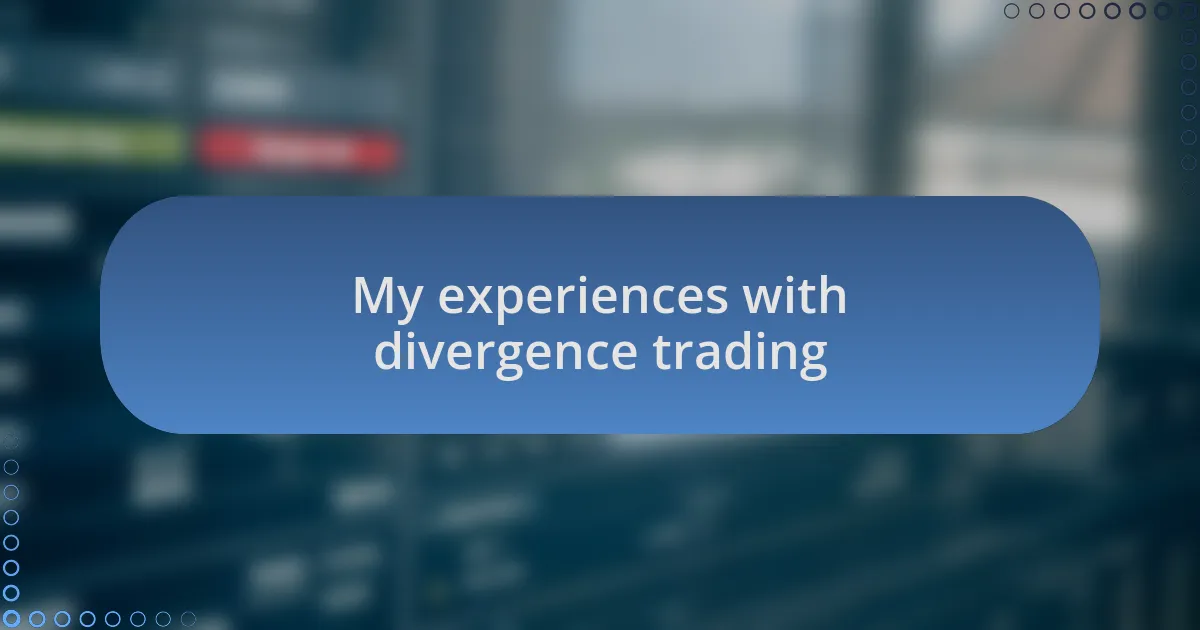
My experiences with divergence trading
My experiences with divergence trading have been a rollercoaster. I clearly remember my first encounter with bearish divergence; I was feeling overly confident after a few good trades. When I spotted the divergence on the chart, however, I hesitated. That moment of doubt cost me dearly, as the market turned against my position shortly after. Has fear ever stopped you from making what you knew was the right call?
As I delved deeper into divergence strategies, I discovered the power of combining them with momentum indicators like the Relative Strength Index (RSI). One particularly memorable trade involved a strong bullish divergence that appeared on the daily chart, coupled with an RSI reading suggesting oversold conditions. Watching my position move in my favor felt incredibly rewarding, almost like the universe was affirming my analysis. I couldn’t help but think, how often do we disregard our gut feelings, only to find they were spot on?
I’ve found that documenting my divergence trades has immensely helped refine my approach. Early on, I’d dive headfirst into trades, often overwhelmed by the emotions of the moment, but keeping a trading journal allowed me to reflect on my decisions. Remembering the exhilaration of successful trades and the lessons from my losses keeps me grounded. Have you ever taken the time to review your own trading journey? It’s fascinating how much insight we can gain by simply looking back.
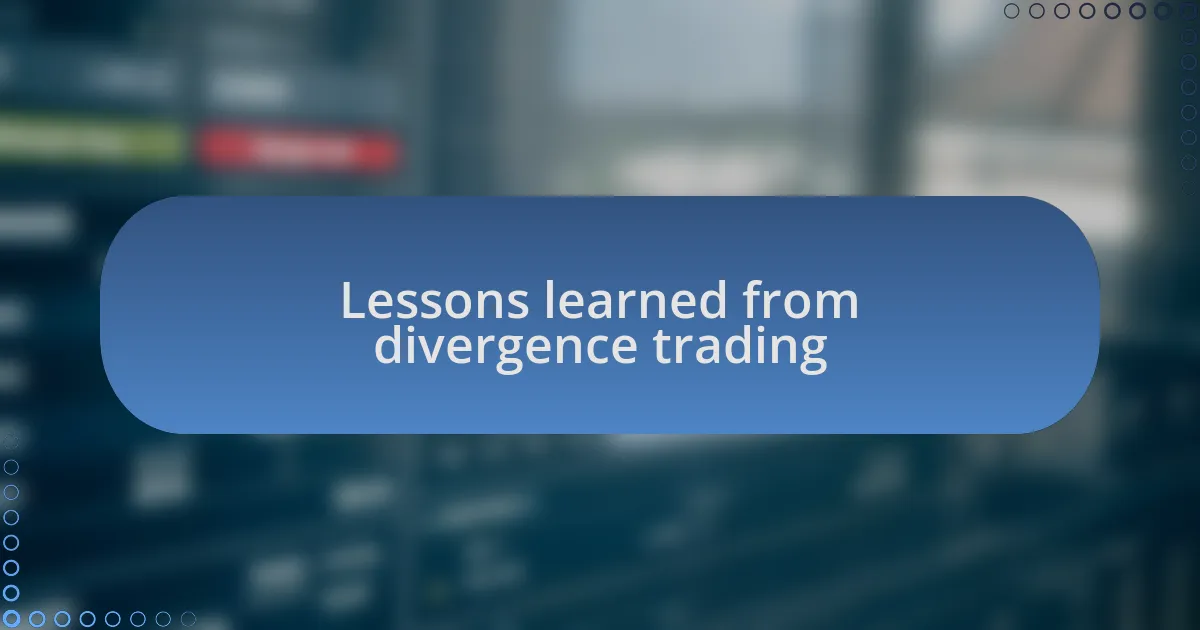
Lessons learned from divergence trading
Divergence trading has taught me the importance of patience. I recall one trade where I spotted bullish divergence but chose to rush in before the confirmation signal appeared. It turned out to be a false start, and I learned that waiting for additional confirmation can make all the difference. How many times have you rushed a decision only to regret it later?
Another key lesson was understanding the emotional rollercoaster that comes with trading. I vividly remember one particularly volatile period when I allowed fear to dictate my actions. I closed out positions too soon, missing out on substantial gains because my emotions clouded my judgment. Isn’t it fascinating how our emotions can mislead us, often leading us away from rational decision-making?
Finally, I’ve come to appreciate the significance of context in divergence trading. There was a time when I focused solely on the divergence signals without considering the overall market trend. It was frustrating to execute what I thought was a sound strategy, only to watch it unravel. Have you considered how broader market conditions might influence your trading choices? It’s clear that harmonizing divergence signals with market context can enhance the effectiveness of trading strategies.